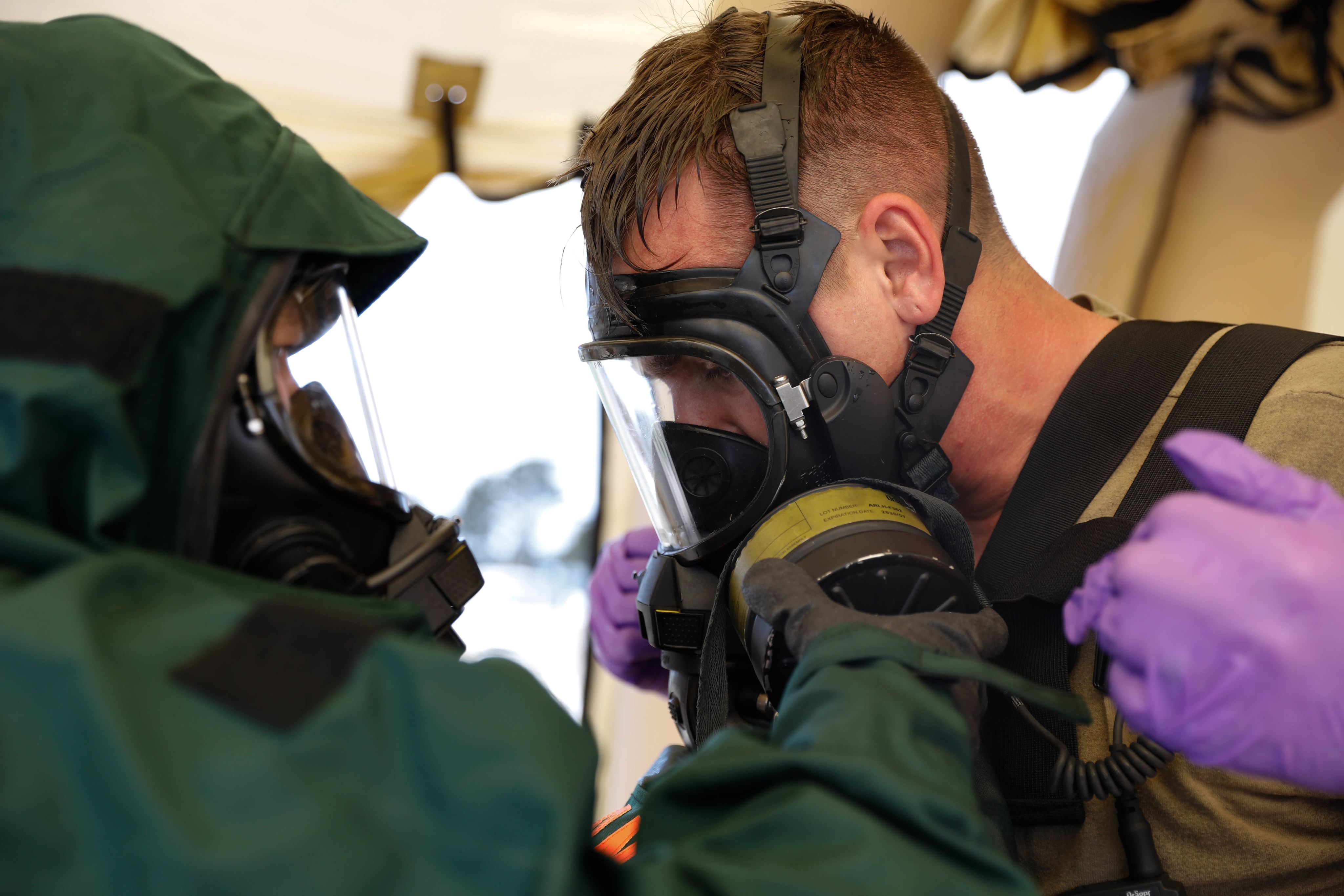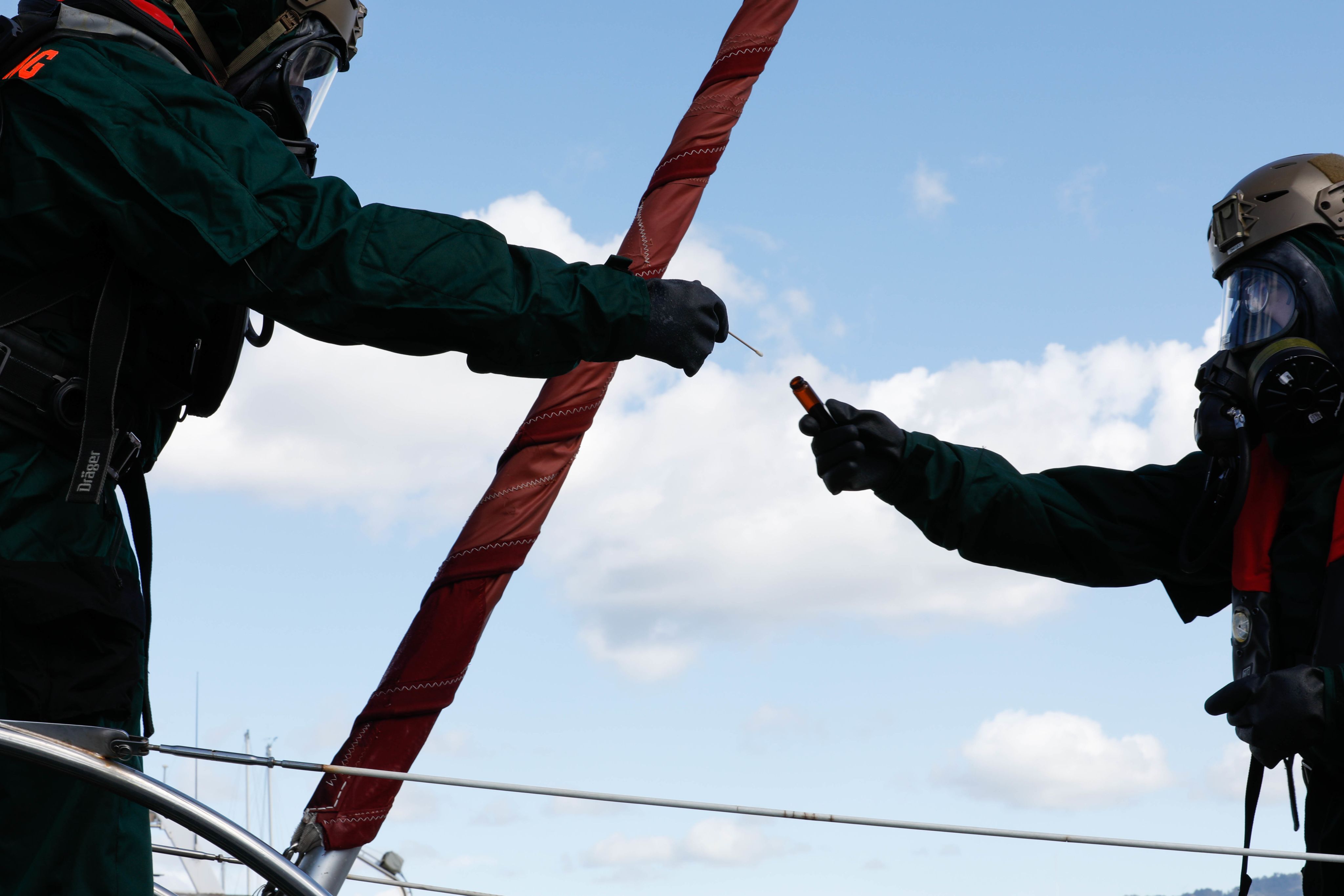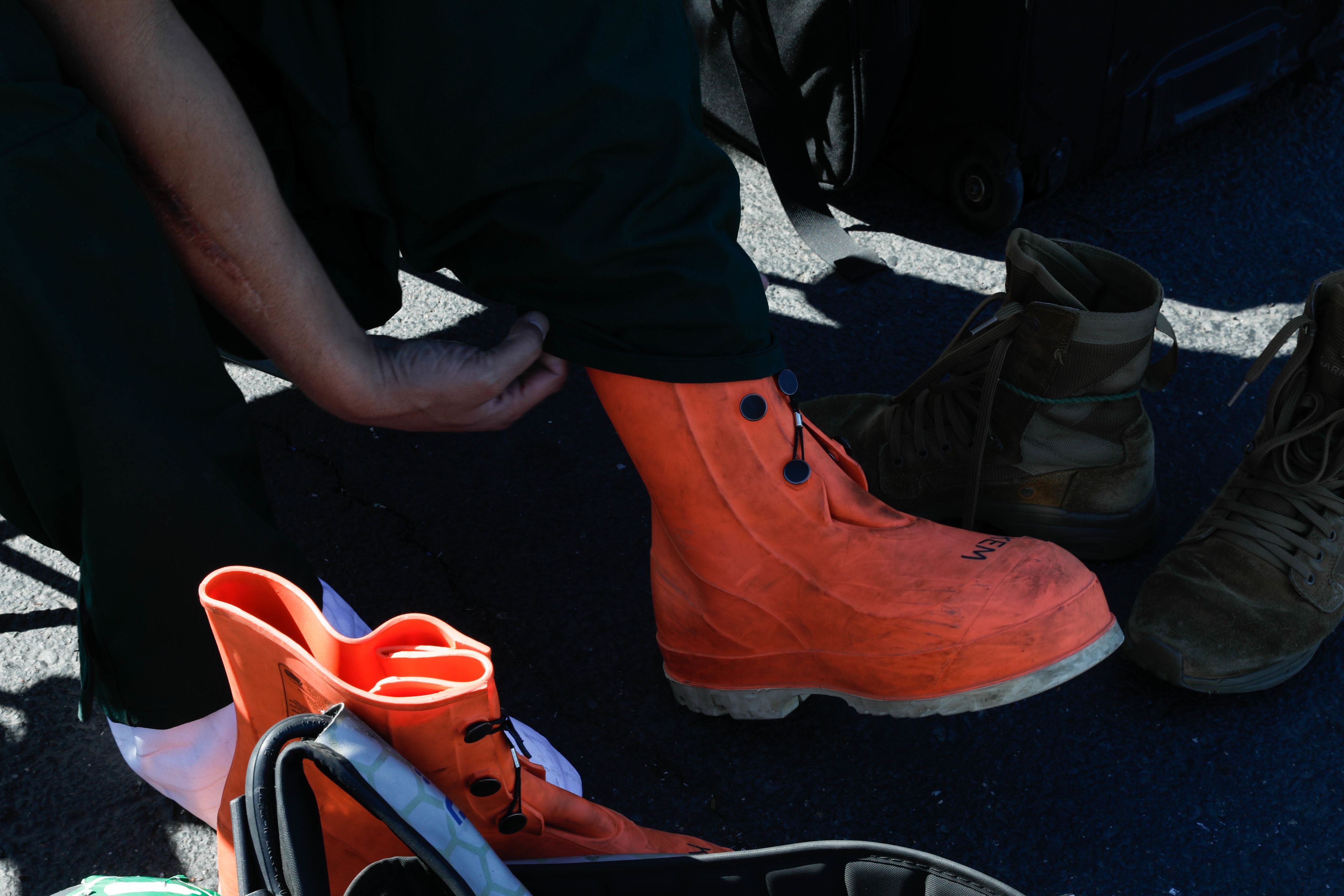BAYEX 2022
95th Civil Support Team trains with law enforcement and first responders in the Bay Area

Story, photos and video by Staff Sgt. Kimberly Hill
California National Guard Public Affairs
March 16, 2022
SACRAMENTO, Calif. – Cal Guard's 95th Civil Support Team participated in BAYEX 2022, an interagency training exercise with local law enforcement and first responders, to test emergency operations in the event of a chemical, biological, radiological, or nuclear attack on mass transit, Feb. 22-25, near San Francisco.
“Taking our time out to train with these folks is critical in maintaining these relationships and keeping our communities safe,” said U.S. Air Force Tech Sgt. Tyler Sullivan, a survey team chief within the 95th Civil Support Team.
Over 400 first responders from nearly 20 different partner agencies participated in the exercise this year, including CAL OES, Alameda County HAZMAT, Oakland City HAZMAT, Oakland City Fire, San Mateo County Public Health, and San Mateo Police Department, as well as members of the Cal Guard’s 9th CST, based at Joint Forces Training Base, Los Alamitos, along with the Nevada National Guard’s 92nd CST.
“There’s a lot of moving pieces in an exercise of this scale, you have a variety of agencies with a lot of different objectives and ways to communicate.”

U.S. Army Staff Sgt. Kevin Kem assists Sgt. Alec Rantanen in removing and decontaminating his chemical suit after searching a mass transit site for hazardous material during BAYEX, 2022, an annual training exercise with local first responders and law enforcement agencies, Feb. 22, Emeryville Marina, Emeryville, Calif. Both Rantanen and Kem are chemical, biological, radiological, and nuclear specialists with the 95th Civil Support Team. (U.S. Army National Guard photo by Staff Sgt. Kimberly Hill)
U.S. Army Staff Sgt. Kevin Kem assists Sgt. Alec Rantanen in removing and decontaminating his chemical suit after searching a mass transit site for hazardous material during BAYEX, 2022, an annual training exercise with local first responders and law enforcement agencies, Feb. 22, Emeryville Marina, Emeryville, Calif. Both Rantanen and Kem are chemical, biological, radiological, and nuclear specialists with the 95th Civil Support Team. (U.S. Army National Guard photo by Staff Sgt. Kimberly Hill)
BAYEX 2022 tested response time on suspected CBRNE contamination from simulated attacks on a variety of mass transportation, including a sailboat, a light rail train, and a public bus.
“There’s a lot of moving pieces in an exercise of this scale, you have a variety of agencies with a lot of different objectives and ways to communicate,” said U.S. Army Sgt. 1st Class Garber, the operations noncommissioned officer in charge with the 95th CST.
The CST provides local law enforcement with expertise and equipment in HAZMAT scenarios, including an entry team that can collect and test suspected CBRNE substances, a mobile lab, decontamination equipment, and additional medical personnel, said U.S. Air Force Maj. Jose M. Barquero, the medical operations officer for the 95th CST.

U.S. Army Sgts. Alec Rantanen and Adan Rosillo, chemical, biological, radiological, and nuclear specialists with the 95th Civil Support Team, collect samples of a simulated unknown substance on a sailboat at the Emeryville Marina in Emeryville, Feb. 22. (U.S. Army National Guard photo by Staff Sgt. Kimberly Hill)
U.S. Army Sgts. Alec Rantanen and Adan Rosillo, chemical, biological, radiological, and nuclear specialists with the 95th Civil Support Team, collect samples of a simulated unknown substance on a sailboat at the Emeryville Marina in Emeryville, Feb. 22. (U.S. Army National Guard photo by Staff Sgt. Kimberly Hill)
“The purpose is to train with them so that everyone can better their response to these types of events.”




U.S. Army Capt. Rory Hight, the operations officer with the 95th Civil Support Team, briefs local law enforcement agencies and first responders during BAYEX 2022, an annual training exercise that tests the 95th CST partner agencies' response to HAZMAT events, at the Emeryville Marina in Emeryville, Feb. 22. (U.S. Army National Guard photo by Staff Sgt. Kimberly Hill)
U.S. Army Capt. Rory Hight, the operations officer with the 95th Civil Support Team, briefs local law enforcement agencies and first responders during BAYEX 2022, an annual training exercise that tests the 95th CST partner agencies' response to HAZMAT events, at the Emeryville Marina in Emeryville, Feb. 22. (U.S. Army National Guard photo by Staff Sgt. Kimberly Hill)

U.S. Army Staff Sgt. Kevin Kem, a chemical, biological, radiological, and nuclear specialist with the 95th Civil Support Team, simulates decontaminating Sgt. Alec Rantanen, a CBRN specialist with the 95th CST, after he returned from searching a sailboat for hazardous materials at the Emeryville Marina in Emeryville., Feb. 22. (U.S. Army National Guard photo by Staff Sgt. Kimberly Hill)
U.S. Army Staff Sgt. Kevin Kem, a chemical, biological, radiological, and nuclear specialist with the 95th Civil Support Team, simulates decontaminating Sgt. Alec Rantanen, a CBRN specialist with the 95th CST, after he returned from searching a sailboat for hazardous materials at the Emeryville Marina in Emeryville., Feb. 22. (U.S. Army National Guard photo by Staff Sgt. Kimberly Hill)

Service members with the 95th Civil Support Team simulate decontaminating members of the Oakland Bomb Squad at the Valley Transit Authority Almaden Light Rail Station in San Jose, Feb 23. (U.S. Army National Guard photo by Staff Sgt. Kimberly Hill)
Service members with the 95th Civil Support Team simulate decontaminating members of the Oakland Bomb Squad at the Valley Transit Authority Almaden Light Rail Station in San Jose, Feb 23. (U.S. Army National Guard photo by Staff Sgt. Kimberly Hill)
“We’re here to support our first responders and their response to a call for a hazardous material scenario. The purpose is to train with them so that everyone can better their response to these types of events,” said Barquero.
The unit regularly trains with law enforcement and first responders in order to maintain open lines of communication, identify and mitigate risks, as well as to gain an understanding of each other’s operations in the event of an emergency event.
“We don’t want to show up to a real-world event and meet our counterparts for the very first time,” said Garber. “When we know their language before an event, we are able to successfully communicate in the event of a HAZMAT situation.”

U.S. Army Sgt. Adan Rosillo, a chemical, biological, radiological, and nuclear specialist with the 95th Civil Support Team, dons his protective boots prior to searching a sailboat at the Emeryville Marina in Emeryville. Feb. 22. Rosillo is part of the entry team of the 95th CST, which is responsible for searching for suspected HAZMAT substances and collecting samples. (U.S. Army National Guard photo by Staff Sgt. Kimberly Hill)
U.S. Army Sgt. Adan Rosillo, a chemical, biological, radiological, and nuclear specialist with the 95th Civil Support Team, dons his protective boots prior to searching a sailboat at the Emeryville Marina in Emeryville. Feb. 22. Rosillo is part of the entry team of the 95th CST, which is responsible for searching for suspected HAZMAT substances and collecting samples. (U.S. Army National Guard photo by Staff Sgt. Kimberly Hill)


